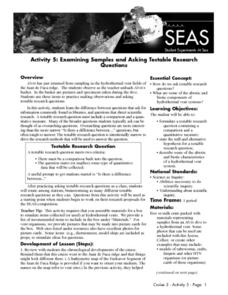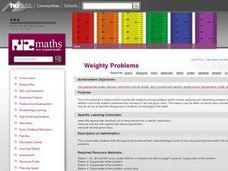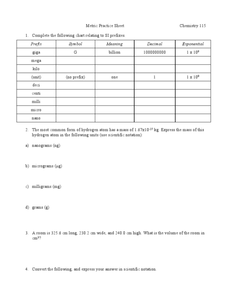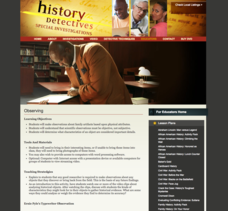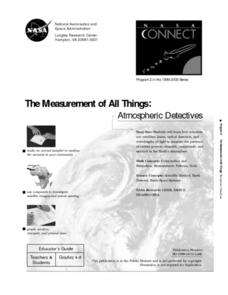Curated OER
The Changing Me
Third graders study the human body. For this health lesson, 3rd graders discuss that everyone's body is growing, measure body parts using a tape measure, and color the body worksheet.
Curated OER
Examining Samples and Asking Testable Research
Students formulate a testable research question containing a comparison and a
quantitative measure. They state the null and alternative hypothesis for a testable research question. In addition, they describe some of the abiotic
and...
Curated OER
Mass: Applying and Interpreting
Young scholars rotate through six studying stations solving problems that involve applying and interpreting aspects of mass. They solve various word problems, and measure the contents of cans and calculate the mass of two cans.
Curated OER
Metric Practice Sheet
In this metric system learning exercise, students solve five problems including filling in a chart with the metric system prefixes and their meanings, converting numbers to scientific notation and converting from one unit of measurement...
Curated OER
Significant Digits
In this significant digits worksheet, students solve fifty six problems which include converting numbers to scientific notation, converting numbers from scientific notation to standard notation, determining significant digits in numbers...
Curated OER
Human Fingerprints: No Two the Same
Sixth graders explore scientific observations by analyzing a group of data. In this fingerprint identification lesson, 6th graders identify the reasoning behind fingerprinting and create their own ink fingerprints. Students discuss the...
Curated OER
Basics of Science
In this basics of science worksheet, students review the metric system, the difference between homogenous and heterogenous mixtures, the scientific method, and science lab first aid. This worksheet has 15 short answer, 43 fill in the...
Curated OER
Theories, Hypothesis, Laws, Facts & Beliefs
In this scientific statements worksheet, students are given 35 statements and they are to identify if each statement is a fact, law, hypothesis, theory or belief.
Curated OER
How Strong is Your Magnet?
Students measure the strength of a magnet and graph how the strength changes as the distance from the magnet increases.
PBS
Observation
Students study making scientific observations . They conduct a "field study" in their attic and make observations about their family artifacts based upon physical attributes. In addition, they determine what characteristics of an object...
Curated OER
The Science of Color
Students use the scientific method to explore how to make different colors with paint. They problem solve ways to darken and lighten colors without using black and white paint. Students hypothesize how to create new colors, and describe...
Curated OER
Photosynthesis Explored
Students observe the production of gas as an effect of photosynthesis. In this biology lesson plan, students perform an experiment with pondweed and make measurements and predictions about photosynthesis and the plant.
Curated OER
Speed and Experiments
In this speed and experiments activity, students read about how to calculate the speed by using the change in distance divided by the change in time. They also read about experimental design and scientific method. Students match 5 terms...
Curated OER
Lesson 5: Designing an Experiment
The intent of this lesson is to introduce young scientists to the steps of the scientific method. To this end, they consider the question, "Which brand of battery lasts longest?" In this case, the experiment is carried out as a class,...
Curated OER
The Measurement of All Things: Atmospheric Detectives
Young scholars identify the characteristics of aerosols. Using remote sensing, they participate in an experiment in which they determine how the sun's radiation and elements in the atmosphere interact with one another. They also...
Curated OER
Instruments and Measurement
Students circulate through stations to determine the proper instrument to make a certain type of measurement. They must make measurements of mass, volume, length, area, electrical current, temperature and force.
EngageNY
Choice of Unit
Explore using units with scientific notation to communicate numbers effectively. Individuals choose appropriate units to express numbers in a real-life situation. For this 13th lesson of 15, participants convert numbers in scientific...
CPO Science
Science Worksheets
If you need an array of worksheets to augment your science lessons, peruse a collection of assignments that is sure to fit your needs. With topics such as metric conversion, the scientific method, textbook features, research skills,...
NASA
Determining the Nature, Size, and Age of the Universe
Prompt scholars to discover the expansion of the universe themselves. Using photographs of other galaxies, they measure and then graph the size and distance of each. Finally, they draw conclusions and prove the universe is...
Edmond Public Schools
8th Grade Science Resource Book: Unit 2 - Physics
Get things moving with this extensive collection of physical science resources. Covering the fundamentals of measurement, graphing, lab safety, and experimental design as well as the specific scientific concepts...
PBS
Blow the Roof Off!
Blow the minds of young scientists with this collection of inquiry-based investigations. Based on a series of eight videos, these "hands-on, minds-on" science lessons engage young learners in exploring a wide range of topics...
Charleston School District
Pre-Test Unit 1: Exponents
How much do you know about exponents? The pre-test covers the concepts of integer exponents with both numerical and algebraic one-variable expressions. The test is also over representing numbers in scientific notation, operating with...
Illustrative Mathematics
How Thick Is a Soda Can II?
Science, technology, and math come together in this one combination exercise. Analyzing the common soda can from both a purely mathematical perspective and a scientific angle allows for a surprisingly sophisticated comparison of...
Newspaper Association of America
Cereal Bowl Science and Other Investigations with the Newspaper
What do cereal, fog, and space shuttles have to do with newspapers? A collection of science investigations encourage critical thinking using connections to the various parts of the newspaper. Activities range from building origami seed...

